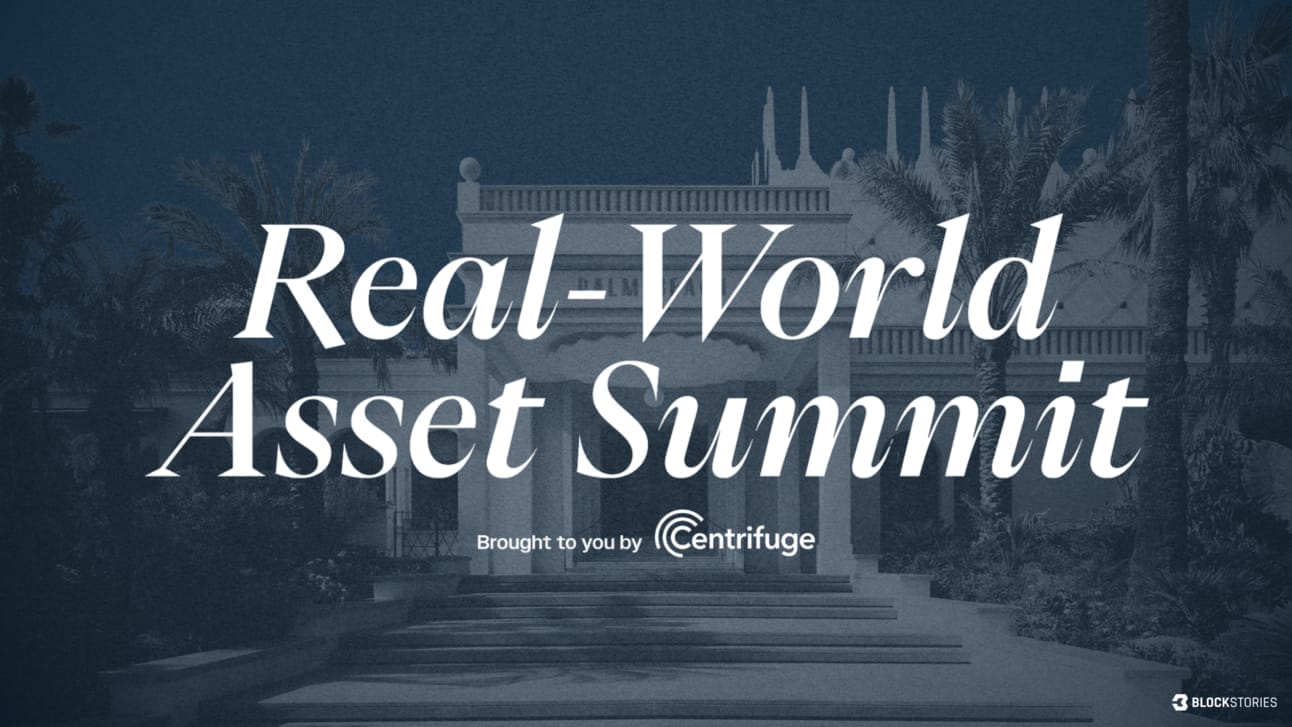- Institutional Briefing
- Posts
- Recap RWA Summit Cannes 2025: S&P, Apollo and the Consensus of Cannes
Recap RWA Summit Cannes 2025: S&P, Apollo and the Consensus of Cannes
Centrifuge’s Real-World Asset Summit draws 300+ decision-makers to the Côte d’Azur — with JPMorgan, Apollo, S&P, and VanEck mapping out what’s next for tokenized markets.

A flagship event for tokenization: On Tuesday, tokenization platform Centrifuge hosted the latest edition of its flagship Real-World Asset (RWA) Summit at the iconic Palm Beach in Cannes, one of the most anticipated gatherings in the space. The event featured more than 50 speakers from across DeFi and TradFi, including executives from JPMorgan, Apex Group, Chainlink, VanEck, Apollo, and Citi.
An optimistic crowd: The day opened with a live poll: when will the onchain RWA market surpass $1 trillion in AUM, up from today’s ~$270 billion (including stablecoins)? The audience leaned bullish with more than half expecting that milestone by the end of 2026.
What’s driving the shift: Speakers attributed the accelerating momentum to three main forces: regulatory tailwinds, infrastructure maturity, and, most critically, a compelling business case. Unlike past narratives centered on long-term cost savings, the current wave of tokenization offers tangible upside which would make it far easier to win executive buy-in.
“What’s interesting from our TradFi perspective is that we’re now seeing new avenues for distribution, reaching an entirely new class of crypto-native investors,” said Christine Moy, Head of Digital Assets at Apollo Global Management. “It’s very exciting to witness the revolutionary changes in investing, distribution, and borrow/lending which happen to be the three core pillars of our business.”
Blockchain’s superpower: Moy also highlighted blockchain’s most underappreciated strength: the ability to unify disparate asset classes on a single programmable infrastructure.
“Once equities, bonds, commodities, and crypto all live on the same ledger, smart contracts can rebalance them automatically. One day, we’ll each have personalized model portfolios, dynamically optimized in real time.”
Adoption barriers persist: Despite the excitement, many speakers acknowledged that major hurdles remain.
Establishment resistance: Ivan de Lastours, Venture Partner at Bpifrance, voiced skepticism about the political will to embrace public infrastructure.
“We’ve told the Banque de France and the ECB directly: put central bank money on a public blockchain. But changing minds is hard. Just look at the latest BIS report on stablecoins and tokenization. It’s not about innovation, it’s about containment.”
Legacy system integration: Keerthi Moudgal, Head of Product at Kinexys by JPMorgan, emphasized that tokenization must adapt to existing institutional infrastructure.
“Many of our clients are accustomed to interacting with their assets through broker-dealers, order management systems, or execution platforms. At scale, tokenized assets need to plug into those same workflows — especially for risk management and reporting.”
Privacy and identity: Moudgal also pointed to challenges with current identity and privacy models onchain.
“An allowlist alone likely won’t scale. We need more flexible forms of identity — whether through credentials or other mechanisms. And privacy is essential. Investing in a single fund might be fine, but exposing an entire multi-asset strategy on a public ledger is a completely different matter.”
S&P 500 goes onchain: Still, the day’s most symbolic moment came when S&P Dow Jones Indices announced the launch of its first tokenized S&P 500 Index Fund. Built in partnership with Centrifuge, Janus Henderson, and Anemoy Capital, the fund uses official S&P data and Centrifuge’s proof-of-index infrastructure.
“This collaboration is designed to create a framework that enables the use of S&P Dow Jones Indices in tokenized fund structures,” said Cameron Drinkwater, Chief Product Officer at S&P Dow Jones Indices. “By making our index data accessible within compliant, blockchain-native environments, we aim to provide a means for the development of financial products that reflects the same quality and rigor investors expect from traditional offerings.”
Asked about the role of public blockchains in this evolution, she added: “Public blockchains offer several unique features, such as programmability and transparency, that can enhance how index-based strategies are implemented. As a result they allow for the creation of financial products that operate with greater efficiency.”

Bhaji Illuminati is the CEO of Centrifuge.
The energy at this week’s Summit made one thing clear: the pace around real-world assets has picked up, and the urgency is real. In the first half of the year, the total value of RWAs has more than doubled, and momentum is only building. Institutions aren’t asking if they’ll adopt tokenization anymore. They're asking how fast?
A number of important announcements were made on stage including the first ever tokenized S&P 500 in partnership with S&P DJI and Centrifuge, the largest single allocation into a tokenized fund from Grove into JAAA on Centrifuge, Multiliquid’s launch, Cap’s stablecoin construction and many, many more. Tokenized assets are moving from a novelty to essential financial market infrastructure.

Maximilian Vargas is the Founder and CEO of Blockstories.
One of the most striking takeaways from the RWA Summit in Cannes was how matter-of-fact the sentiment had become: as a financial institution, of course you’ll (also) need to build on public chains. That’s where global access, scalability, and the fastest pace of innovation are found.
This shift is creating powerful new flywheels: tokenized assets attract more tokenized assets, all benefiting from 24/7 settlement, composability, and programmability. You can see the beginnings with Apollo, VanEck, Janus Henderson, and others bringing their fund products onchain and actively engaging with crypto-native capital.
But there’s still a gap. Asset managers are leaning into DeFi. Banks still seem less interested. The RWA Summit made that visible, too: investor-heavy rooms, few banks, and near-total absence of European institutions. When the value proposition is global distribution, asset managers have the edge. Banks, with their focus on regulatory boundaries and balance sheet control, are moving on a different timeline.
Reply